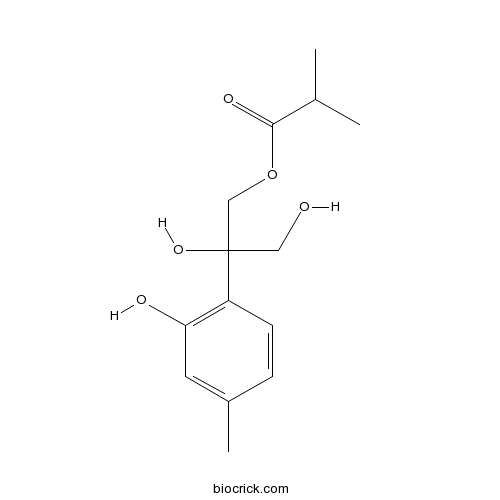8,9-Dihydroxy-10-isobutyryloxythymolCAS# 107109-97-7 |

Quality Control & MSDS
3D structure
Package In Stock
Number of papers citing our products

| Cas No. | 107109-97-7 | SDF | Download SDF |
| PubChem ID | 14427472 | Appearance | Powder |
| Formula | C14H20O5 | M.Wt | 268.31 |
| Type of Compound | Phenols | Storage | Desiccate at -20°C |
| Solubility | Soluble in Chloroform,Dichloromethane,Ethyl Acetate,DMSO,Acetone,etc. | ||
| Chemical Name | [2,3-dihydroxy-2-(2-hydroxy-4-methylphenyl)propyl] 2-methylpropanoate | ||
| SMILES | CC1=CC(=C(C=C1)C(CO)(COC(=O)C(C)C)O)O | ||
| Standard InChIKey | HGIHDUILBYERQC-UHFFFAOYSA-N | ||
| Standard InChI | InChI=1S/C14H20O5/c1-9(2)13(17)19-8-14(18,7-15)11-5-4-10(3)6-12(11)16/h4-6,9,15-16,18H,7-8H2,1-3H3 | ||
| General tips | For obtaining a higher solubility , please warm the tube at 37 ℃ and shake it in the ultrasonic bath for a while.Stock solution can be stored below -20℃ for several months. We recommend that you prepare and use the solution on the same day. However, if the test schedule requires, the stock solutions can be prepared in advance, and the stock solution must be sealed and stored below -20℃. In general, the stock solution can be kept for several months. Before use, we recommend that you leave the vial at room temperature for at least an hour before opening it. |
||
| About Packaging | 1. The packaging of the product may be reversed during transportation, cause the high purity compounds to adhere to the neck or cap of the vial.Take the vail out of its packaging and shake gently until the compounds fall to the bottom of the vial. 2. For liquid products, please centrifuge at 500xg to gather the liquid to the bottom of the vial. 3. Try to avoid loss or contamination during the experiment. |
||
| Shipping Condition | Packaging according to customer requirements(5mg, 10mg, 20mg and more). Ship via FedEx, DHL, UPS, EMS or other couriers with RT, or blue ice upon request. | ||
| Description | 1. 8,9-Dihydroxy-10-isobutyryloxythymol shows in vitro antibacterial and antifungal effects. |
| Targets | Antifection |

8,9-Dihydroxy-10-isobutyryloxythymol Dilution Calculator

8,9-Dihydroxy-10-isobutyryloxythymol Molarity Calculator
| 1 mg | 5 mg | 10 mg | 20 mg | 25 mg | |
| 1 mM | 3.727 mL | 18.6352 mL | 37.2703 mL | 74.5406 mL | 93.1758 mL |
| 5 mM | 0.7454 mL | 3.727 mL | 7.4541 mL | 14.9081 mL | 18.6352 mL |
| 10 mM | 0.3727 mL | 1.8635 mL | 3.727 mL | 7.4541 mL | 9.3176 mL |
| 50 mM | 0.0745 mL | 0.3727 mL | 0.7454 mL | 1.4908 mL | 1.8635 mL |
| 100 mM | 0.0373 mL | 0.1864 mL | 0.3727 mL | 0.7454 mL | 0.9318 mL |
| * Note: If you are in the process of experiment, it's necessary to make the dilution ratios of the samples. The dilution data above is only for reference. Normally, it's can get a better solubility within lower of Concentrations. | |||||

Calcutta University

University of Minnesota

University of Maryland School of Medicine

University of Illinois at Chicago

The Ohio State University

University of Zurich

Harvard University

Colorado State University

Auburn University

Yale University

Worcester Polytechnic Institute

Washington State University

Stanford University

University of Leipzig

Universidade da Beira Interior

The Institute of Cancer Research

Heidelberg University

University of Amsterdam

University of Auckland

TsingHua University

The University of Michigan

Miami University

DRURY University

Jilin University

Fudan University

Wuhan University

Sun Yat-sen University

Universite de Paris

Deemed University

Auckland University

The University of Tokyo

Korea University
- Adipic dihydrazide
Catalog No.:BCC8810
CAS No.:1071-93-8
- Apo-12'-Lycopenal
Catalog No.:BCC8298
CAS No.:1071-52-9
- EIT hydrobromide
Catalog No.:BCC6824
CAS No.:1071-37-0
- O-Phosphorylethanolamine
Catalog No.:BCN1759
CAS No.:1071-23-4
- Amyloid Beta-Peptide (12-28) (human)
Catalog No.:BCC1044
CAS No.:107015-83-8
- Granisetron HCl
Catalog No.:BCC1060
CAS No.:107007-99-8
- Sarcosine
Catalog No.:BCN2744
CAS No.:107-97-1
- H-ß-Ala-OH
Catalog No.:BCC2851
CAS No.:107-95-9
- 3-Methyl-1-butylamine
Catalog No.:BCN1810
CAS No.:107-85-7
- N-Methyltaurine
Catalog No.:BCN1751
CAS No.:107-68-6
- Betaine
Catalog No.:BCN6303
CAS No.:107-43-7
- Taurine
Catalog No.:BCN1750
CAS No.:107-35-7
- Perindopril Erbumine
Catalog No.:BCC3586
CAS No.:107133-36-8
- Pyrocincholic acid methyl ester
Catalog No.:BCN5873
CAS No.:107160-24-7
- MAC13243
Catalog No.:BCC1727
CAS No.:1071638-38-4
- Deoxyflindissone
Catalog No.:BCN7268
CAS No.:107176-31-8
- AT-406 (SM-406)
Catalog No.:BCC1283
CAS No.:1071992-99-8
- Epigoitrin
Catalog No.:BCN6278
CAS No.:1072-93-1
- Cevimeline
Catalog No.:BCC1470
CAS No.:107233-08-9
- 2-[(1S)-2-Formyl-1,3,3-trimethylcyclohexyl]-4-hydroxy-5-propan-2-ylbenzaldehyde
Catalog No.:BCN3584
CAS No.:1072444-55-3
- NPPB
Catalog No.:BCC6711
CAS No.:107254-86-4
- Baogongteng C
Catalog No.:BCN1873
CAS No.:107259-50-7
- Carasinol D
Catalog No.:BCN8228
CAS No.:1072797-66-0
- MLN2238
Catalog No.:BCC2092
CAS No.:1072833-77-2
Asterisulphoxide and asterisulphone: two new antibacterial and antifungal metabolites from the Tunisian Asteriscus maritimus (L.) Less.[Pubmed:24824823]
Nat Prod Res. 2014;28(18):1418-26.
Two new sulphur-containing metabolites, asterisulphoxide 1 and asterisulphone 2, together with six known compounds, coniferaldehyde 4, 4-hydroxy-2-methoxybenzaldehyde 3, methylcaffeate 5, isobutyrate 10-isobutyryloxy-8,9-epoxythymyle 6, 8,9-Dihydroxy-10-isobutyryloxythymol 7 and 8-hydroxy-9,14-diisobutyryloxythymol 8, were isolated from Asteriscus maritimus roots. Their structures were elucidated on the basis of spectroscopic evidence and comparison with authentic samples. Compounds 1-8 were assessed for their in vitro antibacterial activity against Pseudomonas aureofasciens, Burkholderia glathei, Bacillus pumilus and their antifungal effects against Aspergillus flavus, Aspergillus niger, Penicillium digitatum, Botrytis cinerea and Fusarium oxysporum f. sp. lycopersici, using the disc diffusion method (20 muL/disc). A remarkable inhibition zone 10-15 mm of the growth of the bacterial and fungal agents was observed. The obtained results suggest that the isolated compounds could be promising abiotic antimicrobial agents.


